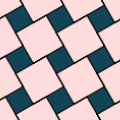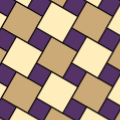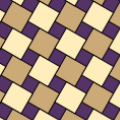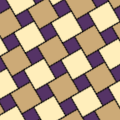File:A tiling in order to prove the Pythagorean theorem.svg

Original file (SVG file, nominally 750 × 600 pixels, file size: 2 KB)
Captions
Captions
Summary
[edit]| DescriptionA tiling in order to prove the Pythagorean theorem.svg |
English: Such periodic tilings can be a mnemonic to depict or prove the Pythagorean theorem with jigsaw puzzles, as shown below. This classical tiling is created from a given right triangle, an Euclidean plane is entirely covered with an infinity of squares, the sizes of which are the leg lengths of the given triangle. On this drawing, every square element of the tiling has a slope equal to the ratio of lengths: a / b = tan θ. Thus a square pattern in dashed red is indefinitely repeated horizontally and vertically: see <pattern id="pg" in the source code. On this image, the square elements of the tiling have a ratio of sizes equal to square root of three or its multiplicative inverse, mathematically written: Assume that the given triangle is not isosceles, so every pattern in dashed red is divided into five polygonal surfaces: three similar triangles and two quadrilaterals. If any piece of a jigsaw puzzle is congruent to one of these five polygons, the total area of five pieces of the five kinds is constant, whatever their assemblage. This total area is the area of a square pattern in dashed red: the squared hypotenuse length, or the area of another assemblage, forming two square elements of the tiling: a 2 + b 2. Hence this identity: a 2 + b 2 = c 2. The visual demonstration of the Pythagorean theorem will be complete with a second image of such a tiling, and a third image about the particular case of an isosceles right triangle, where a pattern in dashed red is divided into four half elements of the tiling. Français : De tels pavages périodiques peuvent être un moyen mnémotechnique pour illustrer ou prouver le théorème de Pythagore avec des puzzles, comme indiqué ci-dessous. Ce pavage classique est créé à partir d’un triangle rectangle donné, un plan Euclidien est entièrement couvert par une infinité de carrés, dont les tailles sont les longueurs des côtés de l’angle droit du triangle donné. Dans ce dessin, chaque élément carré du pavage a une pente égale au rapport des longueurs : a / b = tan θ. Ainsi un motif carré en rouge pointillé est indéfiniment répété horizontalement et verticalement : voir <pattern id="pg" dans le code source. Dans cette image, les éléments carrés du pavage ont un rapport de tailles égal à racine carrée de trois ou son inverse, écrit mathématiquement: |
| Date | |
| Source | Own work |
| Author | Baelde |
| Other versions |
Pythagorean theorem A right triangle is given, from which a periodic tiling is created, from which puzzle pieces are constructed. On three previous images, the hypotenuses of copies of the given triangle are in dashed red. On left, a periodic square in dashed red takes another position relative to the tiling: its center is the one of a small tile. And one of the puzzle pieces is square, its size is the one of a small tile. The four other puzzle pieces have stripes. They can form together a large tile, and they are congruent, because of a rotation a quarter turn around the center of any tile that leaves unchanged the tiling and the grid in dashed red. Therefore the area of a large tile equals four times the area of a striped piece. In case where the initial triangle is isosceles, the midpoint of any segment in dashed red is a common vertex of four tiles with equal sizes: a = b, and each striped piece is still a quarter of a tile, it is an isosceles triangle. Whatever the shape of the initial triangle, the two assemblages of the five puzzle pieces have equal areas: Periodic tilings by squares SVG images coded with a pattern element |
| SVG development InfoField | This /Baelde was created with a text editor. |
Licensing
[edit]- You are free:
- to share – to copy, distribute and transmit the work
- to remix – to adapt the work
- Under the following conditions:
- attribution – You must give appropriate credit, provide a link to the license, and indicate if changes were made. You may do so in any reasonable manner, but not in any way that suggests the licensor endorses you or your use.
- share alike – If you remix, transform, or build upon the material, you must distribute your contributions under the same or compatible license as the original.

|
Permission is granted to copy, distribute and/or modify this document under the terms of the GNU Free Documentation License, Version 1.2 or any later version published by the Free Software Foundation; with no Invariant Sections, no Front-Cover Texts, and no Back-Cover Texts. A copy of the license is included in the section entitled GNU Free Documentation License.http://www.gnu.org/copyleft/fdl.htmlGFDLGNU Free Documentation Licensetruetrue |
File history
Click on a date/time to view the file as it appeared at that time.
| Date/Time | Thumbnail | Dimensions | User | Comment | |
|---|---|---|---|---|---|
| current | 13:32, 19 October 2012 |  | 750 × 600 (2 KB) | Baelde (talk | contribs) | {{Information |Description ={{en|1=This classical tiling is created from a given right triangle: a complete covering of an Euclidean plane with an infinity of ... |
You cannot overwrite this file.
File usage on Commons
The following 25 pages use this file:
- Commons:Categories for discussion/2018
- Commons:Categories for discussion/2018/09
- Commons:Categories for discussion/2018/09/Category:Academ Pythagorean theorem and tiling; plain tilings
- File:A Pythagorean tiling View 1.svg
- File:A Pythagorean tiling View 2.svg
- File:A Pythagorean tiling View 3.svg
- File:A Pythagorean tiling View 4.svg
- File:A Pythagorean tiling View 5.svg
- File:A Pythagorean tiling View 6.svg
- File:A Pythagorean tiling View 7.svg
- File:A Pythagorean tiling View 8.svg
- File:A tiling in order to prove the Pythagorean theorem.svg
- File:A tri-colored Pythagorean tiling View 1.svg
- File:A tri-colored Pythagorean tiling View 2.svg
- File:A tri-colored Pythagorean tiling View 3.svg
- File:A tri-colored Pythagorean tiling View 4.svg
- File:A tri-colored Pythagorean tiling View 5.svg
- File:A tri-colored Pythagorean tiling View 6.svg
- File:A tri-colored Pythagorean tiling View 7.svg
- File:A tri-colored Pythagorean tiling View 8.svg
- File:Academ Periodic tiling by squares of two different sizes.svg
- File:Academ Periodic tiling by squares of two kinds.svg
- File:Academ Pythagorean tiling and Pythagorean theorem.svg
- File:Academ Squares of two kinds in a periodic tiling.svg
- File talk:A Pythagorean tiling View 1.svg
Metadata
This file contains additional information such as Exif metadata which may have been added by the digital camera, scanner, or software program used to create or digitize it. If the file has been modified from its original state, some details such as the timestamp may not fully reflect those of the original file. The timestamp is only as accurate as the clock in the camera, and it may be completely wrong.
| Width | 750 |
|---|---|
| Height | 600 |





















